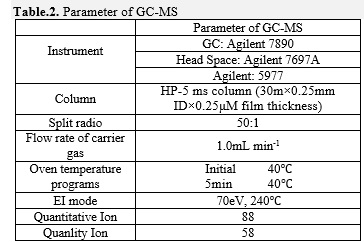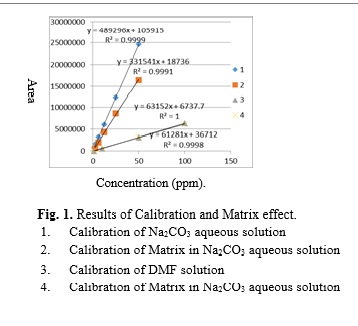Introduction: A novel three-dimensional(3D) porous scaffold PLGA/TCP/Mg was made by 3D printing for bone defect repair. 1,4-dioxane was used during scaffolds preparation process and it was hard to be removed completely. As Chinese Pharmacopoeia specified 1,4-dioxane should be limited below 380 ppm in order to protect patients from potential adverse effects. It is mandatory to test residual 1,4-dioxane for PLGA/TCP/Mg registration in CFDA. The aim of this paper was to describe a quantitative determination of 1,4-dioxane in scaffold, focusing on the impact of sample preparation.
Materials and Methods: Porous scaffolds were cut into 3 mm3 of particles with the weight of 0.15g for each one,Process of sample preparation was stated in Table.1[1].

Calibration curves for 1,4-dioxane were established according to sample preparation. Sample for experiment of blank matrix effect following the method in Table. 1. External standard method was used in the quantification of 1,4-dioxane.
Paraments of GC-MS for all detections were summarized in Table. 2.

Temperature and cycle time of head space of sample dissolved in DMF were 90℃ and 45 min, respectively. Temperature and cycle time of head space of Na2CO3 aqueous solution were 70℃ and 40min, respectively[2].
Results and Discussion: This study compared direct injection and headspace injection, and found that direct injection had more interference, worse separation, and large molecule of PLGA in the material can pollute the instrument, so that it was more suitable for test of 1,4-dioxane using headspace injection.
In the Na2CO3 aqueous solution, processed under headspace condition, the detecting sensitivity is 5 times higher than that in DMF, but in the Na2CO3 aqueous solution, it can be disturbed by the matrix strongly, and due to the propriety of the sample, this method can not promise high accuracy.
Dissolving sample in DMF, was able to remove the matrix effect (the linear correlation coefficient and the corresponding concentration area were also close), and achieve more accurate quantitative method. The linear correlation coefficient of this method is 0.9998,(Fig.1) and the recovery per cent is 105.41%-107.99%.

Conclusions: Porous of the scaffolds affected the remove of the organic solvents. So the sample preparation is essential for the accuracy of the determination of remained 1,4-dioxane. In this study, we found the most effective preparation was that porous scaffolds were disolved with DMF and injected by Head Space. Our results provided basis for determination of residual solvent of porous scaffolds.
National Natural Science Foundation of China (81302782,81171771); NSFC-DG-RTD Joint Scheme (51361130034); The Opening Project of Shanghai Key Laboratory of Orthopaedic Implants(KFKT2014001)
References:
[1] William M. Draper,Jagdev S. Dhoot, John W,et al.Trace -level determination of 1,4-dioxane in water by isotopic dilution GC and GC-MS[J]. Analyst, 2000, 125: 1403-1408.
[2] Ho-sang shin, Hyun-Hee Lim, et al. Determination of 1,4-Dioxane in Water by Isotopic Dilution Headspace GC-MS[J]. Chromatographia, 2001,73: 1233-1236.